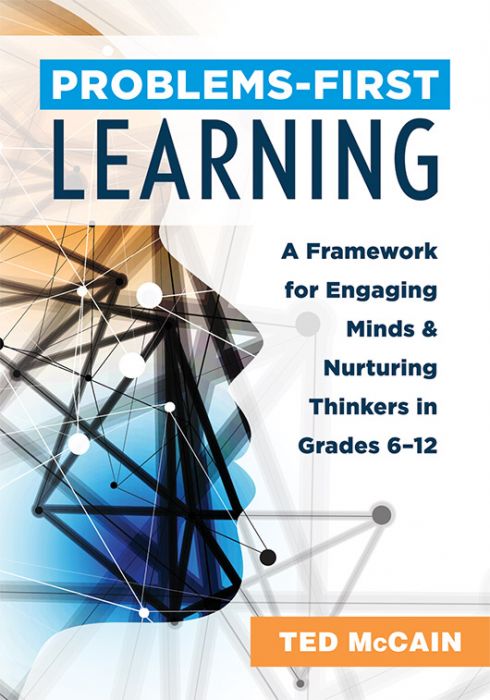
Problems-First Learning
A Framework for Engaging Minds and Nurturing Thinkers in Grades 6–12
Fully engage students by first introducing a problem and then empowering learners to solve it using creativity, innovation, collaboration, and other essential skills. Gain instructional methods that foster whole-mind learning, boost student engagement, and prepare learners for the modern workforce with 21st century skills.
Add this eBook to your credit card purchase and gain immediate access.
eBooks are available on desktop, Android, and iOS via Adobe Digital Editions. eBook purchases are limited to one eBook per title, per account. Please visit the eBook FAQ for more information.
A teacher’s guide to boosting student engagement with the instructional method of problems-first learning
The educational pattern of lecture, listen, and forget is deeply ingrained in schools. In this user-friendly resource, author Ted McCain offers a compelling alternative that flips lessons on their heads: the problems-first instructional method. Using this method, you will fully engage students by first introducing a problem and then empowering learners to solve it using creativity, innovation, collaboration, and other essential skills.
- Identify the need for instructional change in the current educational system.
- Consider the transferrable skills students need for solving problems in the workplace and in life outside the classroom.
- Study the benefits of a problems-first teaching style.
- Learn to implement problems-first methods into existing classrooms.
- Understand how this method teaches seven essential 21st century skills highly desired in the modern workforce.
- Discover how to introduce role-play into the classroom and broaden lessons to encompass whole-mind learning and boost student engagement.
Related Topics
21st Century SkillsInstructionStudent Engagement
Additional Information
“Ted’s genius in this book is reframing the school curriculum from content that needs to be covered to a problem that needs to be solved. By adopting a problems-first approach, schools and teachers can use Ted’s very practical ‘4 Ds’ approach (define, design, do, and debrief) to make student learning more authentic and engaging. I highly recommend this book that’s filled with practical strategies and techniques for anyone who’s interested in shifting student work from convergent regurgitation to divergent action and meaning-making.”
“I have had the privilege of knowing Ted McCain for over twenty years as a teaching colleague and as the principal of the secondary school where Ted teaches. Throughout this time, I have continually been inspired by his pedagogical leadership. Yet, it wasn’t until my daughter signed up for Ted’s classes year after year that I truly understood the power of his problems-first approach to learning. Rosie, in the process of developing solutions to Ted’s problems, had to bring her own personality, interests, and abilities to each challenge. Furthermore, Ted designed his lessons so that she had to be resourceful, collaborative, and creative to succeed. To this day, Rosie has credited ‘Mr. McCain’ with teaching her how to learn, and in this book, Ted makes his methods clear to us all.”
“In a fast-changing world, in which students are inundated with mind-boggling amounts of information, it is important to teach them to be problem seekers rather than problem solvers. Ted McCain has captured this approach elegantly. Through the use of definitive research and personal reflection, Ted lays out how any teacher can bring a problem-first approach to any learning environment.”
“As Ted McCain so accurately articulates, acquisition of knowledge is an old educational paradigm. What is needed in today’s rapidly changing digital world is for students to be able to identify problems and implement strategies to systematically develop solutions. For the educator or school that is reflecting on how to deepen its students’ educational experience, McCain provides a compelling path. He clearly lays out the arguments for using problems-first learning, then shares insightful and engaging examples of how to implement this game-changing understanding of deep learning. I have seen personally that the implementation of these ideas has provided our students with a distinct advantage as they leave our school to continue their journeys in our ever-changing world.”
When can I access my eBook? Your eBook will be accessible through VitalSource once your payment has been processed.*
*When using a check or purchase order, the order submitted online will not be processed until Solution Tree receives the check or a copy of the signed official purchase order. Your purchase order must note payment terms of net 30 days. We cannot process purchase orders that do not note these payment terms. Please submit all payments to [email protected].
How do I access my eBook?
To access your eBook:
- Create a free VitalSource account by visiting VitalSource.com. If you already have a VitalSource account, please log in to your account.
- Paste the redemption code that Solution Tree will email you in the “Redemption Code” field on VitalSource.com/Redeem. (Note: You can also access your redemption code within your Solution Tree account under the “eBook” section.)
- Click “Redeem.”
- Enjoy! Once your code is redeemed, your book will be added to your VitalSource Bookshelf and can be read anytime, anywhere.
What are the technical requirements for accessing the eBook? A VitalSource account is required. To sign up for your free account, please visit VitalSource.com.
What if I have trouble accessing my eBook? Please contact VitalSource by emailing [email protected] or by utilizing their Live Chat feature.
What are the shipping and handling costs? There are no shipping or handling costs associated with eBooks. For paperback and hardcover book purchases, standard shipping costs apply. Please visit the Product Orders page for more information on shipping and handling costs.
Can I purchase multiple copies of the same eBook? Bulk orders are not currently available through the website. Website purchases are limited to one eBook per title, per account. If you want to order multiple copies of an eBook, please contact customer support at [email protected].
What if I need to request a refund on my eBook order? RETURN POLICY: We are unable to accept returns or cancel previously placed eBook orders.
